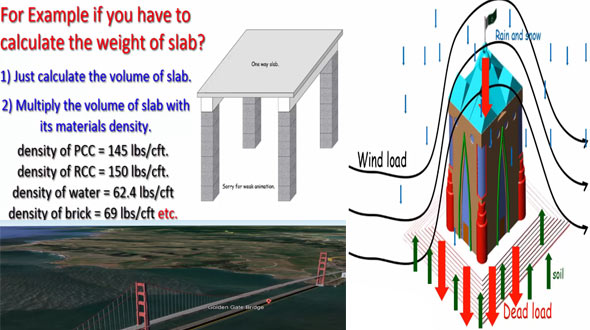Major types of loads on building structures
- Concrete Cost Estimator
- Concrete Continuous Footing
- Landscape Bidding and Estimating
- Construction Cost Estimating
- Concrete and steel cost estimation
- Construction Cost Estimate Breakdown
- Construction Estimating Worksheet
- Home Construction Cost Estimate
- Estimate Pricing Sheet
- Sheet for General Contractor
- Construction Cost Estimate
- Labor Materials Cost Estimator
- Masonry Estimating Sheet
- Sheet for Building Contractor
- Construction Schedule Bar chart
- General Cost Estimator Sheet
- General Construction Estimate
- Building and Road Estimating Sheet
- Detailed expense estimates
- Door and Window Takeoff Sheet
- General Construction Cost Estimating Sheet

S.L. Khan, the renowned engineer, provides brief explanation on the various types of loads which operate on structures.
The loads are imposed on a completed or temporary structure throughout and as a result of the construction process
Loads are categorized as follow :-
1) Dead loads.
2) Live loads.
3) Environmental loads.
DEAD LOADS: Dead loads mean the loads which are constant in magnitude and set in location during the life span of the structure. Generally, the major part of the dead load is the self weight of the structural systems like walls, columns, beams, space frame, cladding material (interior & exterior), slabs, partition walls as well as weight of other permanent service equipment HVAC or plumbing).
These can be found with exact precision from the design configuration, structure dimensions and density of the material.
For buildings the weight of floor fills, finish floor and plaster ceilings are generally considered as dead loads. An allowance is provided for suspended loads like piping and lighting fixtures. For bridges dead loads may comprises of wearing surfaces, sidewalks and curbs, and an allowance is provided for piping and other suspended loads.
LIVE LOADS: Live loads are generally unsteady or just moving loads, or it can be said that live loads mainly comprising of occupancy loads in buildings and traffic loads on bridges.
They contain all the movable weights ranging from human, furniture and fixtures as well as other non structural components like rain, snow & ice. The wind pressure, water pressure or push of earth are also treated as live load. They are either fully or partially in place or not exist at all, may also vary location wise. Their magnitude and distribution at any stipulated time are unpredictable. Their maximum intensities during the Life time of the structure can’t be determined exactly.
The minimum live loads applicable to design the floors and roof of the building are mentioned in the building code that is controlled at the construction site. The illustrative values of minimum live loads should be applied in different types of buildings which are set up in minimum design loads for buildings and other structures.
The type of occupancy should be taken into consideration and the projected loads are measured as precisely as possible. Live loads for highway bridges are stated by the American association of state highway and transportation officials (AASHTO) in its LRFD bridge design specifications.
ENVIRONMENTAL LOADS: Environmental Loads are loads generated with natural forces like wind pressure, rain load, snow load, earthquake loads, soil pressure on subsurface structures as well as temperature difference. These loads are changed instantly or employed abruptly.
Environmental loads at any stipulated time are dubious in both distribution and magnitude.
To get more clear ideas with diagrams, go through the following video tutorial.
Video Source: SL Khan

- Application of concrete calculator
- Roofing Calculator can streamline the roof estimating process
- House construction cost calculator
- Engineering column design excel spreadsheet
- Material Estimating Sheet with Excel
- Materials List and Cost Estimate Worksheet
- Concrete Slab Estimating Calculator Sheet
- Common types of foundations for buildings
- Online calculation of construction materials
- Estimating with Excel for the Small Contractor
- Concrete Beam Design Spreadsheet
- Virtual Construction Management app for construction
- Autodesk’s Project Skyscraper
- Reed Construction’s Reed Insight
- Manage your construction project documentation
- Costimator, the popular cost estimating software
- On Center Software for construction professionals
- Free Construction Estimating Software
- Plumbing Calc Pro
- Cost Estimate Worksheet
- HVAC Piping Quantity Takeoff Worksheet
- Construction Estimating Software Sheet
- Estimate Cost Templates
- Construction Punch List
- Construction cost estimating template consisting estimating basic
- Gantt Chart Template for Excel
- Download Civil Engineering Spreadsheets with Verification
- The Building Advisor Estimating and Budgeting Worksheet
- Spreadsheet for design of concrete bridge
- Construction Estimating Software Free








